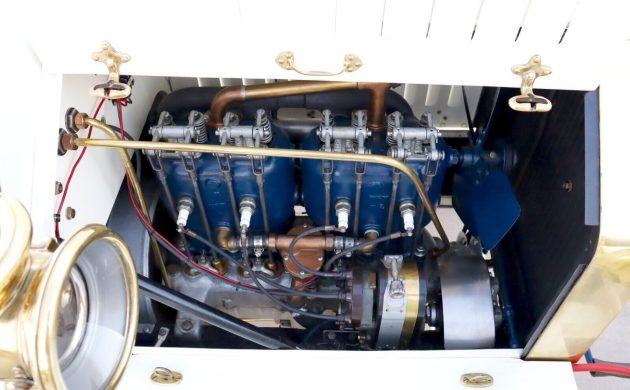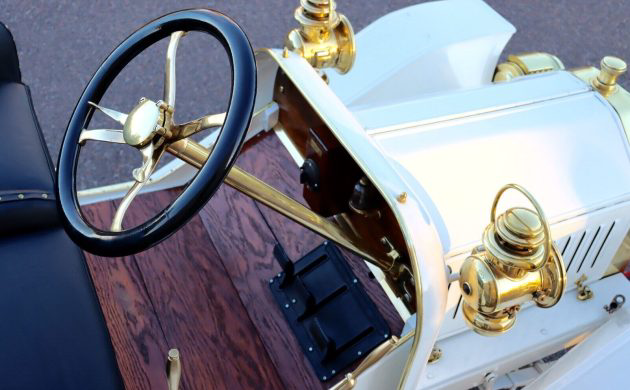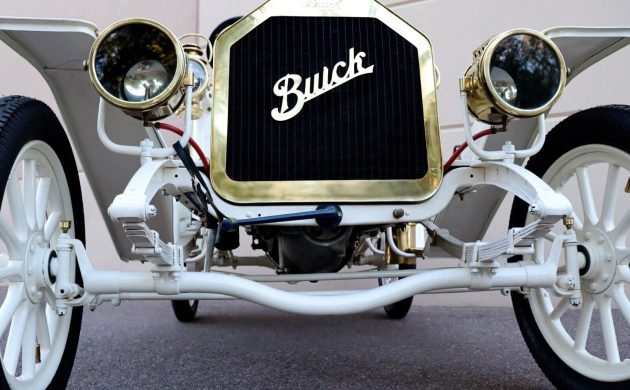The Brass Era represented the shake-out period for that thing called the horseless carriage. Kicking off in about 1896 and extending until the last Model T came off the line in 1915, the Brass Era was characterized by small-batch manufacturing, fast innovation, a wide variety of fuels, and of course, lots of brass fittings. Standards were gradually developing – like Panhard’s front engine layout – but mostly, auto manufacturing was a free-for-all. Into this crucible was born Buick. David Buick wasn’t keen to make autos, being more captivated by marine engines. Nonetheless, engineer Walter Marr came up with two cars, one built in 1899 and the other in 1900. In 1904, the company received a patent for its two-cylinder overhead valve engine – a critical event that made Buick the centerpiece of General Motors. William Durant acquired most of Buick that same year, and shortly afterward introduced the Buick 4, with an OHV four-cylinder, designed to compete with the Model T. Here on eBay is a member of the Buick 4 family, a 1909 Buick Model 10 Surrey Seat, bid to $17,100, reserve not met. A buy-it-now option is available, at $27,995. This car is located in Phoenix, Arizona.
The engine is a perfect example of pre-monobloc construction, with the cylinders cast in pairs and the valves visible at the top of the casting. Horsepower generated by this 165 cu. in. four comes in about 22, and the car is capable of 50 mph though owners indicate in forums that a comfortable speed is around 35 mph. The gearbox is a planetary type, with a leather cone clutch, two forward speeds, and reverse. Movement is controlled by pedals and a hand lever. Starting is by hand crank only. For a great “tour” of the Model 10 mechanicals, see this video.
And there’s that steering wheel, on the right-hand side. The hand brake and gear control are on the right as well. What gives? That’s a holdover from the typical horse team arrangement: the driver would ride the left rear wheel horse and control the team (steer) with his right hand on the reins. Most early cars in America were right-hand drive until road standards began to dictate driving on the right: the first “keep right” law was passed in 1792 in Pennsylvania. The Model T was the first left-hand drive car produced in significant numbers, as Henry Ford believed that passengers – women particularly – would prefer to enter a car from the curb to avoid oncoming cars, mud, dust, and ruts of the road. The oil lamps work; and note that glass canister, just visible to the near left of the steering wheel: that is your oil indicator. It will fill about one-third with oil from the engine as it’s running if all is well. No, windshields were not yet standard, and most Model 10s only provided a top if the buyer paid extra.
The headlamps are acetylene-based, run by that Badger Solar generator in the link above. This photo shows the cart-spring arrangement used on cars for many years before suspensions evolved. Yes, those are wooden artillery wheels. This car was meticulously restored a few years ago and remains pristine, but values are heinously low. Mid-twenties is about the right number, but what the market will bear on this one is yet to be seen.





Many factory issued swag to Buick dealers in the 50’s and 60’s, including placemats, coaters, pen sets, and even a lighter, had this model featured. My grandfather had all of them…
This is one beautiful brass era car. It amazes me how much things changed and developed over time. Cars back then were a rich persons toy, but look what happened.
I wouldnt even want to drive this, its just too nice. The technology back then too was really something else. Ive seen quite a number of Prestolite tanks over the years and remember my father telling me they were for the lights on early day cars. I hope they can get something for it, its probably a small market for something like this.
Thank goodness Ralph Nader wasn’t around in 1910 to declare this car (and virtually every automobile produced in the early days) “unsafe at any speed” and the idea of motor cars would have gone by the wayside. I’m jus say’n.
Great comment on Ralph Nader! LOVE the car! Not certain I could learn to drive it.
What a beautiful car. It is a good value at the asking price and should reach a sale. In my younger years I really hankered for a car like this because there are brass era tours that usually have a cutoff around 1909. This would be a pretty sophisticated car to participate in them and would be a lot of fun. I hope it finds someone that is young at heart to enjoy it to its fullest.
Among other things, we can thank David Dunbar Buick for the process that attaches the porcelain to the steel/ iron in our sinks and bathtubs…!
Anyone remember Buicks corney ad…”B _ I C K” the only thing missing is U” lol
Lovely car, informative article on something a bit different for Barn Finds.
Hope it finds the right home.
BTW, RHD was normal on many European luxury brands until WW2. In fact, Lancia didn’t sell LHD cars until the early 1950s, though probably just out of misplaced traditionalism in that case.
The first picture is of a model of the car because in the video he says it’s a 4 seater.
You may want to look at the eBay listing.
Brass era car ownership, driving, tours are very much alive and well. HCCA is the premeire horseless carriage club, with many members and cars. Each year the Gilmore hosts a brass era week, with days of shows activities and three days touring the Kalamazoo area countryside. Nothing to be afraid of driving these, just stay off the freeways. Oh, the joy! Get the car, come on and join us!
This car may have been restored, but as a retired carpenter I’d be surprised if the floorboards originally looked like they do here.
This looks cheap.
Excellent looking brass era Buick ! Thanks for the info.
“My Buick, My Love, And I” https://youtu.be/hXCEt1Ap-2s?si=-lgy1yupm9Dsmqnw
“My Buick, My Love, and I” https://youtu.be/hXCEt1Ap-2s?si=-lgy1yupm9Dsmqnw
Very nice! It seems that the older I get the more I appreciate the Brass Era cars. We should be grateful for them as they spawned the idiocy that we all suffer from today. I got my first taste of Brass when my Dad ordered in “The Treasury of the Automobile” back when I was in Second Grade. A 1901 Pope Columbia Mk VIII had me enthralled and still has my attention today. Some of those cars are really great. This car could come to my place…
Minor quibble – Model Ts were produced until 1927.
Interesting information about the standarization of driving on the right side, and that the Model Ts were the first mass produced left side driver vehicles.
While this is a nice write up most of the years stated are incorrect, along some pertinent information. Surprisingly an event was left out that would change the automotive industry forever. A couple notable things; Bill Durant took control over Buick in 1904 but GM was not formed until 1908. The model T came out at the end of 1908 as an ’09 model. Obviously Buicks produced years earlier were not competing against a Ford that was not created yet let alone having the years to create it’s popularity. The end of the brass era was at the end of the teens. Ford continued to make the Model T until May of 1927. In the years before Bill Durant purchased Buick David Buick was known to have a good car but had no ability to market it. He contacted a Swiss race car driver who was in France making a name for himself. David Buick convinced him to come to the US and race his cars as a way to market his cars with hopeful wins. The race car driver was Louis Chevrolet. Obviously a long story from here before Louis Chevrolet and his brother ran a successful company manufacturing overhead valve cylinder heads for Fords. Some very interesting history in the early days of the automotive industry.